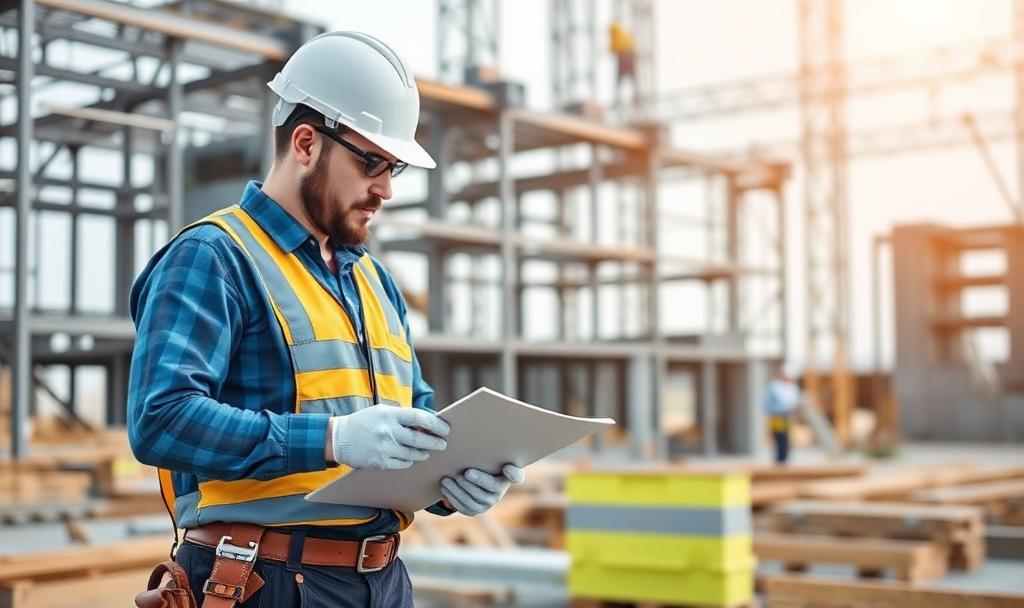Building project management is an intricate and multifaceted discipline that requires a blend of experience, strategy, and creativity. At McNedra Construction, we understand the importance of effective construction project management in bringing commercial spaces to life. This guide will explore critical aspects such as project planning, risk management, and stakeholder communication to ensure a successful build from inception to completion.
Table of Contents
Understanding the Building Project Management Framework
Welcome to the exhilarating world of building project management, where vision meets reality, and sometimes, where best-laid plans meet Murphy’s Law. Understanding the framework of building project management is pivotal, not only for successful projects but also for keeping your sanity intact. Let’s unravel this intricate web, step by step.
The Core Components of Building Project Management
- Project Planning: At the heart of any construction endeavor lies meticulous project planning. This phase involves defining objectives, identifying resources, and crafting a roadmap to success. A study by the Project Management Institute highlights that 39% of projects fail due to a lack of proper planning. Clearly, it pays to plan!
- Cost Estimation: Money may not grow on trees, but it sure disappears fast without accurate cost estimation. This component involves budgeting based on material costs, labor, and even those unexpected hiccups that inevitably arise.
- Project Scheduling: Think of this as your project’s GPS. It guides you from groundbreaking to ribbon-cutting with timelines that help avoid detours.
- Resource Allocation: Ensuring the right people are doing the right jobs at the right times is resource allocation in a nutshell. It’s like playing construction chess—one wrong move could topple your queen (or in this case, your project).
- Risk Management in Construction: Identifying potential risks before they become costly issues is essential. According to a 2022 report from Deloitte, risk management significantly improves project outcomes when integrated into early planning stages.
Navigating Challenges with a Strategic Approach
The path from blueprint to building can be rife with challenges—contractor coordination mishaps, regulatory compliance puzzles, or unexpected delays in procurement. Yet these can often be mitigated through strategic planning and agile approaches such as lean construction techniques.
“Failing to plan is planning to fail.” – Alan Lakein
An example of effective application can be seen in commercial building projects across Calgary: clear stakeholder communication and streamlined contractor coordination have been key factors in driving success stories. For those embarking on retail store constructions in Calgary, understanding these dynamics can turn potential pitfalls into stepping stones for success (read more about retail store construction here).
The Future is Green and Smart
Sustainable building practices and cutting-edge technologies like BIM (Building Information Modeling) are reshaping how projects are managed today. McNedra Construction is at the forefront of integrating these innovations into their processes.
If you’re considering diving into a new construction venture or renovation project, choosing an experienced partner who understands these elements can make all the difference (learn more about choosing a management partner here).
The framework for building project management isn’t just about bricks and mortar; it’s about creating spaces that inspire while keeping budget constraints firmly in check. With expertise and dedication—like those demonstrated by our passionate team at McNedra Construction—even the most ambitious visions can become functional realities.
Effective Project Planning for Success

Embarking on any construction journey without a solid plan is like jumping into a marathon with your shoelaces untied. Not the best idea! Effective project planning is the backbone of successful building project management. It’s the roadmap that guides your project from inception to completion, ensuring each milestone is met on time and within budget. So, how do you master the art of project planning? Let’s delve in!
The Art and Science of Project Scheduling
The first step in crafting a robust plan is to establish a clear project schedule. This involves breaking down the entire project into manageable tasks, setting timelines, and identifying dependencies. Tools like Gantt charts can be invaluable here, offering a visual representation of the project’s timeline and helping to keep everything on track.
- Set Clear Objectives: Define what success looks like for your project, aligning with stakeholders’ expectations.
- Identify Milestones: Break down your project into key deliverables to track progress effectively.
- Avoid Overlapping Tasks: Ensure task dependencies are well understood to prevent bottlenecks.
Mastering Resource Allocation
Resource allocation can make or break a construction project. Efficiently managing resources—be it manpower, materials, or machinery—is critical for maintaining momentum. According to McKinsey & Company, large projects typically take 20% longer to complete than scheduled and are up to 80% over budget. Proper resource allocation can help mitigate these inefficiencies.
Consider using resource management software that integrates seamlessly with your scheduling tool to optimize availability and utilization.
The Budget Balancing Act
No one likes surprises when it comes to project expenses. The key to successful cost estimation lies in detailed budgeting during the planning phase. Break down costs into categories such as labor, materials, equipment, and contingencies.
“A budget tells us what we can’t afford, but it doesn’t keep us from buying it.” – William Feather
Clever budgeting includes allocating funds for unexpected surprises; because let’s face it, Murphy’s Law loves construction sites! For those embarking on commercial projects in Calgary, consider exploring options such as office space construction services by McNedra Construction.
Communication: The Glue in Project Planning
Last but not least is stakeholder communication—a critical yet often underestimated component of effective planning. Establish open lines of communication from day one with all parties involved. Whether through regular meetings or digital platforms like Slack or Microsoft Teams, keeping everyone informed reduces misunderstandings and keeps morale high.
A well-structured communication plan should outline who needs information and when they need it. After all, there’s nothing worse than finding out about a crucial design change via the grapevine!
With these components firmly in place—project scheduling mastery, strategic resource allocation, astute budgeting skills, and seamless stakeholder communication—you’re equipped to navigate the intricate terrain of building projects successfully.
(And hopefully without too many coffee spills along the way!)
The Importance of Risk Management in Construction

In the dynamic world of construction, risk management is not just a buzzword; it’s the backbone of any successful building project. Picture this: you’re assembling a complex jigsaw puzzle with thousands of pieces. Now imagine if some pieces had the potential to explode into confetti if not handled correctly. Welcome to the thrilling world of construction project management!
At its core, risk management in construction involves identifying, assessing, and mitigating potential pitfalls that could derail a project. From fluctuating material costs to unexpected regulatory changes, the potential risks are as varied as they are numerous.
Why Is Risk Management Crucial?
- Minimizing Financial Losses: Unanticipated challenges can lead to significant cost overruns. By proactively managing risks, projects can stay within budget, ensuring financial stability.
- Avoiding Delays: Construction timelines are notoriously tight. Effective risk management helps anticipate scheduling hiccups, thus avoiding costly delays.
- Ensuring Safety: Safety management in construction projects is paramount. Identifying potential hazards before they occur can prevent accidents and ensure a safe working environment.
A study by McKinsey & Company highlights that large construction projects typically take 20% longer to finish than scheduled and can be up to 80% over budget (source). These staggering statistics underscore the importance of robust risk management strategies.
The Art of Risk Management: Tips for Success
- Identify Risks Early: The earlier you spot potential issues, the more options you have for resolving them.
- Create a Risk Register: Document all identified risks in a register and update it regularly during the project’s lifecycle.
- Prioritize Risks: Not all risks carry equal weight. Use techniques like risk matrices to prioritize them based on impact and likelihood.
- Develop Contingency Plans: A well-prepared contingency plan can be your best friend when things don’t go as planned.
If you’re looking for expert partners who understand the intricacies of risk management and more, consider exploring how to choose a construction management partner.
“The greatest glory in living lies not in never falling, but in rising every time we fall.” — Nelson Mandela
This quote perfectly encapsulates why adaptability and resilience are essential in managing risks effectively. With vigilant oversight and strategic planning, even unforeseen events can be navigated successfully without compromising project goals.
Budgeting and Cost Control Techniques
Mastering the art of building project management requires a keen eye on the budget—a critical aspect that can make or break a project. While it’s tempting to dream big with grandiose designs, ensuring those dreams fit within fiscal reality is where true expertise shines. Here’s a look at essential techniques for effective budgeting and cost control in construction projects.
Developing a Detailed Project Budget
A well-established budget begins with precise cost estimation. This involves an exhaustive breakdown of every conceivable cost, from materials and labor to permits and unforeseen expenses. Remember, budgeting without details is like baking without a recipe—possible, but potentially disastrous.
- Material Costs: Document all materials required, accounting for price fluctuations in the market. It’s not just about bricks and mortar; even nails count!
- Labor Costs: Include all personnel involved, from construction workers to project managers. Ensure that estimates reflect accurate wage rates.
- Permit Fees: Adhering to regulatory compliance requires securing necessary permits. These fees should be factored into preliminary budgets.
A detailed budget isn’t merely a starting point—it’s your roadmap throughout the project lifecycle. Regular updates ensure you stay on track financially.
Implementing Cost Control Measures
“A penny saved is a penny earned,” or in construction terms, it’s potentially thousands saved on overruns! Implement these cost control strategies to keep your financials healthy:
- Project Scheduling: Efficient scheduling prevents delays which often lead to increased costs. A well-coordinated timeline minimizes downtime and maximizes productivity.
- Resource Allocation: Smart allocation of manpower and machinery optimizes operations. Avoid overstaffing or underutilizing equipment by planning meticulously.
- Regular Audits: Conduct frequent financial audits to identify potential overspending early. This proactive approach enables timely corrections before it impacts the bottom line.
Tackling Unforeseen Expenses
No matter how thorough your planning, surprises are inevitable—like when you find out your building site was once an ancient alien landing pad (kidding… mostly). Setting aside a contingency fund addresses such unexpected expenses without derailing the entire project budget.
The Role of Technology in Budget Management

The advent of technology has revolutionized many aspects of commercial building project management, including budgeting. Utilizing tools like Building Information Modeling (BIM) can enhance accuracy in cost estimation and facilitate ongoing financial tracking throughout the project’s phases.
The application of these budgeting and cost control techniques ensures that while visions might soar high, feet remain firmly planted on solid financial ground!
Coordination with Stakeholders and Contractors
The art of building project management often resembles a complex dance, where coordination with stakeholders and contractors sets the rhythm. Ensuring seamless communication and collaboration between all parties involved is crucial for the success of any construction project. Let’s delve into how you can master this orchestration.
Understanding Stakeholder Priorities
First things first—get to know your stakeholders on a deeper level. Whether they’re investors, government bodies, or future occupants, understanding their priorities can significantly influence the project’s direction. Transparency is key; hold regular meetings to ensure everyone is on the same page.
- Tip: Use digital tools like Trello or Slack for real-time updates.
- Example: In a commercial building project management scenario, investors might prioritize cost efficiency while tenants focus on design aesthetics.
The Contractor Connection: Building Relationships
Your contractors are your boots on the ground, so it’s vital to establish strong relationships with them. A little humor goes a long way here—after all, construction is tough work! Scheduling regular check-ins helps in aligning project goals and addressing any concerns early on.
“A great relationship with your contractor can turn an obstacle into an opportunity,” says leading construction expert Mark Williams. “It’s all about effective communication.”
Choosing the right construction management partner can further enhance these relationships by providing expert guidance and support throughout the process.
Navigating Challenges: Conflict Resolution
No building project is without its hiccups—think unexpected weather changes or sudden design alterations. Being proactive in conflict resolution can make all the difference. Develop a conflict resolution strategy that includes:
- A clear chain of command for decision-making.
- A designated mediator for resolving disputes.
- An open forum for discussing potential issues before they escalate.
This structured approach helps maintain momentum and keeps everyone focused on the end goal: completing a high-quality building project on time and within budget.
Remember: The key to successful coordination lies not just in managing tasks but also in managing relationships. With robust stakeholder communication and contractor coordination, you’re well on your way to mastering the intricacies of building project management!
Sustainability and Innovative Practices in Construction
In today’s increasingly eco-conscious world, the construction industry stands at a pivotal crossroads. The integration of sustainable practices and innovative building techniques is not just a trend; it’s a necessity. As a forward-thinking player in the construction game, McNedra Construction is devoted to sustainability and innovation, ensuring that our impact on the environment is minimized while maximizing efficiency and quality.
Green Building Practices
- Energy-efficient Designs: From solar panels to high-performance insulation, modern construction leverages energy-efficient solutions that reduce operational costs and carbon footprint.
- Water Conservation: Implementing greywater recycling systems and low-flow fixtures helps conserve precious resources.
- Sustainable Materials: Utilization of materials like bamboo, recycled metal, and reclaimed wood not only reduces waste but also supports sustainable forestry initiatives.
A shining example of green building success is the Bullitt Center in Seattle, hailed as one of the world’s greenest commercial buildings. It generates its own energy through rooftop solar panels and uses rainwater to meet all water needs. Such innovative practices are redefining what it means to be “green” in construction.
The Role of Technology
The construction sector has always been fertile ground for technological innovation. Technologies such as Building Information Modeling (BIM) are revolutionizing project planning by providing detailed 3D models that help teams visualize structures before they’re built. This minimization of errors during the actual build process makes BIM an invaluable tool for modern-day projects.
Moreover, the advent of drones for site surveying and 3D printing for creating complex structural components has further propelled the capabilities of construction management into new realms. These technologies enhance project efficiency, reduce costs, and improve safety standards on-site—a win-win for everyone involved!
“Sustainable development is the pathway to the future we want for all. It offers a framework to generate economic growth, achieve social justice, exercise environmental stewardship and strengthen governance.” – Ban Ki-moon
The Future: Eco-Friendly Innovations
As we look ahead, sustainable building practices will continue evolving with innovations like smart grids and energy storage solutions becoming more mainstream. The integration of Internet of Things (IoT) devices into infrastructure will also play a significant role in optimizing resource use across urban landscapes (think smart lighting, heating systems).
If you’re planning a project that prioritizes sustainability without sacrificing quality or function, consider how McNedra Construction can bring your vision to fruition by leveraging our expertise in commercial building project management.
For more insights into sustainable construction practices or to get started on your next green project journey with us, check out our latest updates on our [sustainability blog](https://mcnedraconstruction.ca/category/sustainability/).
Ensuring Quality Control in Construction Projects

The cornerstone of any successful building project management strategy is ensuring quality control throughout the construction process. Without a doubt, even the most meticulously planned project can falter if quality slips through the cracks. So, how do we keep those cracks from forming? Let’s explore some essential strategies.
Establishing Clear Standards and Benchmarks
First and foremost, it’s crucial to establish clear quality standards and benchmarks right from the start. This involves defining the desired quality level for materials, workmanship, and processes. Much like setting your GPS before a road trip, having these benchmarks helps guide every decision along the way.
- Define Quality Metrics: Establish key performance indicators (KPIs) that are specific, measurable, achievable, relevant, and time-bound (SMART).
- Set Regular Checkpoints: Incorporate regular reviews and inspections to ensure compliance with established standards.
The Role of Technology in Quality Assurance
Embracing technology can be a game-changer in maintaining quality control. Tools such as Building Information Modeling (BIM) provide detailed project models that can help identify potential issues before they become real problems.
“Projects that implement BIM technology see up to 40% reductions in unbudgeted changes.” – Construction Dive
BIM not only enhances visualization but also aids in coordination and communication among all stakeholders involved.
Training and Engaging Your Workforce
A well-trained workforce is pivotal for achieving high-quality results. Regular training sessions ensure that everyone on site understands the latest techniques and safety protocols. Moreover, engaged employees who take pride in their work tend to deliver superior results—because let’s face it, no one wants to be known for shoddy craftsmanship!
Involving Stakeholders Through Transparent Communication
Nurturing open lines of communication with all stakeholders is vital for maintaining quality control. Regular updates and transparent reporting ensure everyone is on the same page—there’s nothing worse than discovering halfway through construction that a critical detail was overlooked because no one shared it!
If you’re looking to embark on a journey of choosing a construction management partner, remember: McNedra Construction believes passionately in transforming visions into reality with uncompromised quality at its core.
Navigating the Final Stages: Completion and Handover
So, you’ve made it through the lion’s share of your building project, and now you’re entering the final stages. Congratulations! But don’t put those hard hats away just yet. The completion and handover phase is a critical juncture in building project management, where every detail matters more than ever. Think of it as the grand finale of a construction symphony—every note must be perfect for a standing ovation.
The Punch List: Dotting the I’s and Crossing the T’s
The punch list might sound like something from a boxing match, but it’s far less combative (we promise). Essentially, it’s a list of tasks that need completion before you can call it a wrap. Here’s what typically makes it onto this list:
- Minor Repairs: Fixing any visible defects in workmanship or materials.
- Final Installations: Ensuring all fixtures and fittings are installed correctly.
- Documentation: Compiling all necessary documents including warranties and manuals.
The punch list is an essential tool for maintaining quality control in construction, helping ensure that everything is up to par before handing over the keys.
The Handover Process: Smooth Sailing Ahead
If you’ve been thorough with your project scheduling and resource allocation, the handover process should be as smooth as one of our polished concrete floors. This is when you officially transition from construction phase to operational use. Here’s how you can ensure it’s seamless:
- Conduct Final Inspections: Both internal teams and external stakeholders should perform thorough inspections to verify compliance with design specifications.
- User Training: Educate your clients on operating any new technology or systems installed—like showing someone how to use their new espresso machine (priorities).
- Official Sign-Offs: Obtain all necessary approvals from regulatory bodies to ensure compliance with local regulations.
“The bitterness of poor quality remains long after the sweetness of low price is forgotten.” – Benjamin Franklin
This old adage rings especially true here. Final inspections are not just about checking boxes; they’re about safeguarding your investment in quality construction management practices.
Acknowledging Stakeholders: Because Gratitude Never Goes Out of Style
You didn’t get here alone—acknowledging the effort of everyone involved is both good manners and best practice. Whether it’s your team who turned blueprints into reality or stakeholders who believed in your vision, a little gratitude goes a long way in strengthening future collaborations.
Navigating these final stages successfully sets up your project for operational success while leaving behind a positive impression—much like finding an extra fry at the bottom of the bag, unexpected but oh-so-satisfying!
In conclusion, successful building project management hinges on a well-rounded approach involving meticulous planning, risk assessment, budget adherence, stakeholder coordination, quality assurance, sustainability considerations, and timely delivery. With these best practices at your disposal from McNedra Construction’s expert team, you’re well-equipped to turn any vision into reality—on time and within budget.
